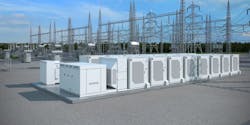Fluence Gridstack to provide Resiliency for massive Energy Storage system in Australia
Energy storage joint venture Fluence has contracted to deliver a 50-MW/50-MWh battery system for grid-forming support in Australia.
Energy utility AGL selected Fluence, formed by Siemens and AES, to provide advanced grid-forming capabilities for the Broken Hill Battery Energy Storage system project funded by ARENA. It will include Fluence’s Gridstack and be part of AGL’s planned 850-MW national battery storage rollout.
The goal is to demonstrate the capability of latest-generation inverter technology to support grid strength in areas of lower power capacity.
Unlike grid-following or other grid-forming energy storage systems in Australia’s National Electricity Market (NEM), AGL’s Broken Hill energy storage system will start and remain in grid-forming mode, with all inverters operating as a voltage source.
The system will inherently resist changes in voltage and frequency on the grid and provide synthetic inertia, also known as Virtual Synchronous Machine (VSM) mode, and fault current contribution.
Related stories
Australian leaders approve Solar-storage-H2 Microgrid for Daintree Rainforest region
“As Australia moves forward with its energy transition, we know that firming technologies like energy storage will be the backbone of renew able energy supply,” AGL Chief Operating Officer Markus Brokhof said.
Fluence’s Aaron McCann, general manager for Australia, said the Broken Hill battery project will dispatch instantaneously to respond to variations in voltage and/or frequency.
Fluence and its partners, including Valmec, are expected to complete the project in 2023.
-- -- --
(Rod Walton, senior editor for EnergyTech, is a 14-year veteran of covering the energy industry both as a newspaper and trade journalist. He can be reached at [email protected]).
About the Author
Rod Walton, EnergyTech Managing Editor
Managing Editor
For EnergyTech editorial inquiries, please contact Managing Editor Rod Walton at [email protected].
Rod Walton has spent 17 years covering the energy industry as a newspaper and trade journalist. He formerly was energy writer and business editor at the Tulsa World. Later, he spent six years covering the electricity power sector for Pennwell and Clarion Events. He joined Endeavor and EnergyTech in November 2021.
Walton earned his Bachelors degree in journalism from the University of Oklahoma. His career stops include the Moore American, Bartlesville Examiner-Enterprise, Wagoner Tribune and Tulsa World.
EnergyTech is focused on the mission critical and large-scale energy users and their sustainability and resiliency goals. These include the commercial and industrial sectors, as well as the military, universities, data centers and microgrids. The C&I sectors together account for close to 30 percent of greenhouse gas emissions in the U.S.
He was named Managing Editor for Microgrid Knowledge and EnergyTech starting July 1, 2023
Many large-scale energy users such as Fortune 500 companies, and mission-critical users such as military bases, universities, healthcare facilities, public safety and data centers, shifting their energy priorities to reach net-zero carbon goals within the coming decades. These include plans for renewable energy power purchase agreements, but also on-site resiliency projects such as microgrids, combined heat and power, rooftop solar, energy storage, digitalization and building efficiency upgrades.

